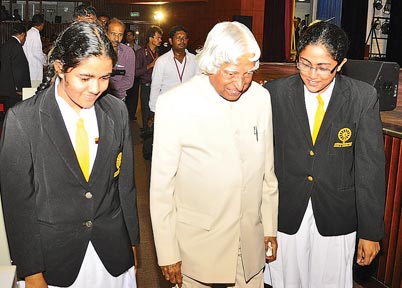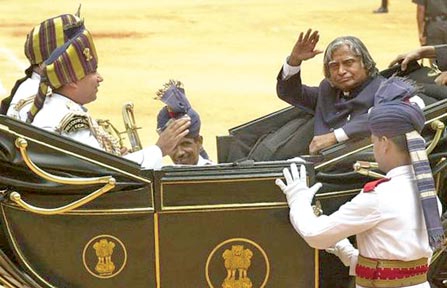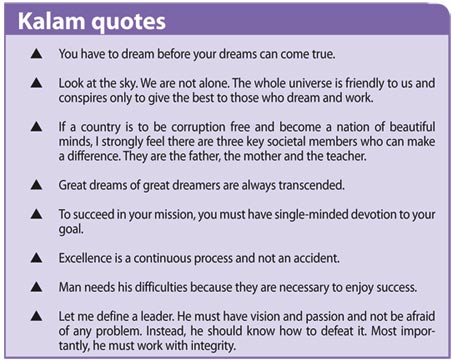 Roots
of Kalam’s charisma Roots
of Kalam’s charisma
Dr. Avul Pakir Jainulabdeen (APJ)
Abdul Kalam, the personification of People’s President, aged 83, died on
July 27 while doing what he loved best - addressing students:
by B.C. Sharma
The widespread outpouring of grief which followed the sudden death of
former Indian President and scientist A. P. J. Abdul Kalam on July 27
was unprecedented in India’s history since the assassination of Mahatma
Gandhi, the father of the nation, in 1948.
The passing away of Indian leaders such as Jawaharlal Nehru, Indira
Gandhi and Rajiv Gandhi also triggered widespread grief across India.
But the machinery of the State or a political party had a major role to
play in organizing and directing the expression of grief. In the case of
Kalam, however, the outburst was unorganized, spontaneous, and natural.
It cut across political, regional, linguistic, communal and generational
divides.
And for all this, Kalam was only an ex-President, who had demitted
office long ago, in 2007, and was almost 84 when the end came.
Kalam was perhaps the only ex-Indian President or Indian ‘leader’ who
continued be in the minds and hearts of the people after retirement. He
continued to write and speak on a variety of issues of people’s concern.
Stood For India’s Aspirations
He was very contemporary in his concerns and urged his listeners and
readers to look to the future instead of dwelling in the past. His aim
was to reach out to all, which made him speak and write in a simple,
easily understandable way. He wrote as many as 17 books, which though
not profound or scholarly, went straight to the hearts and minds of the
reader, ‘igniting’ them to work vigorously for a better tomorrow for
all, especially the underprivileged.
Kalam became popular because in his person, life and achievements, he
stood for India’s aspirations, its youth’s aspirations. Dilip D’Souza
writing in the website Scroll.in described it thus:
 “This
man, remember, was a boatman’s son from Rameswaram in Tamil Nadu; from
there, he grew up to be a scientist and engineer. His is a nation, after
all, in which generations of parents have sought to turn their children
into engineers (to be fair, doctors too). “This
man, remember, was a boatman’s son from Rameswaram in Tamil Nadu; from
there, he grew up to be a scientist and engineer. His is a nation, after
all, in which generations of parents have sought to turn their children
into engineers (to be fair, doctors too).
“It remains a profession revered like few others. Only its
practitioners, we believe, can and will transform India into that
promised land so many yearn for: powerful, developed, filled with
skyscrapers and expressways and gleaming airports. And president Kalam
was one such practitioner. In a long line of politicians who have
occupied the Presidency, this man of science stood out. Simply by doing
so, he stood for a nation’s aspirations.”
Swimming against the anti-nuclear and anti-military current coursing
through a vocal section of the Indian intelligentsia, Kalam was an
outspoken advocate of the acquisition of nuclear and ballistic missile
technologies right through. In this area too, he voiced the feelings of
the younger generation of Indians and the middle classes which wanted
India to be a major generator of power and militarily strong. Though a
man of peace, he was practical in these matters. “When the neighbourhood
is nuclear, we in India cannot be doing tapas (meditation)” he told an
interviewer.
Youth Icon
Unlike many others, Kalam did not go hunting for audiences or canvass
for invitations to speak. Invitations to talk kept pouring in from every
nook and corner of India, and audiences eagerly flocked to his lectures
in great numbers. True to form, he was lecturing to students of the
Indian Institution of Management in Shillong in North Eastern India when
a cardiac arrest claimed his life.
 Kalam’s
target audience was the youth, especially, university and school
students, aspiring entrants into a challenging new world. And he won
them over lock, stock and barrel. As former Indian Minister Shashi
Tharoor noted: “With his long silvery hair unfashionably combed back and
his thick Tamilian accent, Kalam was an unlikely pop culture idol, but
that was what he became.” Kalam’s
target audience was the youth, especially, university and school
students, aspiring entrants into a challenging new world. And he won
them over lock, stock and barrel. As former Indian Minister Shashi
Tharoor noted: “With his long silvery hair unfashionably combed back and
his thick Tamilian accent, Kalam was an unlikely pop culture idol, but
that was what he became.”
Kalam set much store by children and youth because they were the
citizens of a morrow which could be shaped as per his grand scheme. He
even assigned to the youth a contemporary role, that of correcting the
distortions characterizing contemporary society. He appealed to children
to question and correct their wayward and corrupt parents.
Kalam started the “What I Can Give Movement” which was meant to get
the citizens of India to find out what they can do for social and
national betterment, especially for alleviation of poverty, instead of
asking what others, the state and society can do for them. Not
surprisingly, Kalam was declared the “MTV Youth Icon” twice, in 2003 and
2006.
Explaining Kalam’s appeal, a Sri Lankan sociologist said: “At times
he was simplistic or banal, but he gave the impression of being a
sincere and good man, qualities which made audiences lap up what he said
as a profound message from a Messiah.” And Dilip D’Souza said: “Here was
a President who actually wanted to mingle with us, to remain one among
us, rather than an unapproachable exaltation on a pedestal. Who would
not respond to that?”
Kalam had always lived simply. When he was a scientist in the Indian
Space Research Organization (ISRO) in Thiruvananthapuram in Kerala, he
would commute by public bus and eat in the Guruvayurappan Saivar Kade
with the hoi polloi, remembers Shashi Tharoor who represents
Thiruvnanthapuram in the Indian Parliament. In a fitting recognition of
Kalam’s status as a ‘Man of the Masses’ the Government of India decided
to bury Kalam, not in Imperial Delhi, but in the tiny town of Rameswaram,
where he was born and raised.
Kalam’s Lankan connection
Like many members of the sea faring
Maraikkar community straddling South India and Sri Lanka.
Abdul Kalam had kinsmen living in Sri Lanka, particularly in
Mannar, Vavuniya, Anuradhapura, Puttalam and Colombo.
According to former MP, A. H. M. Azwer,
Kalam ‘s sister’s husband (Mamanaar) was living in
Anuradhapura till he relocated at Chilaw about three years
ago. Some distant kinsmen of the late Indian President are
still in Keselwatte in Hulftsdorp.
“None of those in Keselwatte is wealthy.
They are either in small trade or in small white collar
jobs,” Azwer said. Kalam himself came from an indigent
family.
Azwer said when Kalam was in Sri Lanka in
January 2012, he had accompanied him throughout his visit to
Jaffna. “He had a great deal of love for Sri Lanka.”
When in Jaffna, Azwer urged Kalam to meet
the Northern Tamil fishermen so that he could learn about
the problems posed to them by intruding Indian fishermen.
Kalam met the fishermen. Looking at the issue from both
sides, he suggested that the fishermen from the two
countries agree to give each other three months’ exclusive
fishing rights.
“If this suggestion had been implemented,
the problem might have neared a permanent solution,” Azwer
said. |
Kalam genuinely cared for his staff, ensured their welfare and
protected them in times of trouble. Former ISRO chief, G. Madhavan Nair,
recalled that when he botched up a rocket launch, Kalam, as head of the
project, took the rap instead of exposing the subordinate’s fault. On
his way to his last lecture in Shillong, Kalam found a soldier standing
on his escort jeep all through the 2.5 hour journey to the hill station.
On reaching the destination Kalam apologized to the man for the
inconvenience he had caused. But the smiling soldier unhesitatingly
replied: “For you Sir, I will stand for six hours if need be!”
Social Focus
Equitable social development had been one of Kalam’s principal
concerns. In 2003, while being President of India, he proposed a scheme
designed to prevent the overcrowding of cities by ‘Providing Urban
Amenities to Rural Areas’ or PURA as Kalam christened it. The PURA
scheme was accepted by the Central Indian government in 2004 and
implemented in some areas. But government later drastically toned down
its scope to cover only sanitation and water supply to make it more
implementable. Kalam however continued to advocate his idea of PURA till
his death.
Hope for the underprivileged
In a developing country where millions are underprivileged and poor,
Kalam had been a beacon of hope, as he had risen from very humble
beginnings to become a distinguished scientist and the President of
India.
Avul Pakir Jainulabdeen Abdul Kalam was born in 1931 in a Maraikkar
boatman cum boat maker’s family of Rameswaram, a coastal fishing cum
Hindu pilgrimage town in Tamil Nadu. Since the family was large and hard
up, Kalam had to supplement its income by doing a part time job as a
newspaper vendor from the age of eight. But being good in Mathematics,
he was able to enter St. Joseph’s College in Tiruchi to do his
Bachelor’s in Physics. Given his passion for planes and flying, he
joined Madras Institute of Technology to do a course in aeronautical
engineering. When he failed to qualify to enter the Air Force as a
trainee pilot, Kalam joined the Aeronautical Development Establishment (ADL)
of the Defence Research and Development Organization (DRDO) of the
Government of India as a junior scientist.
In 1969, Kalam was transferred to the Indian Space Research
Organization (ISRO) where he became Director of India’s first Satellite
Launch Vehicle (SLV-III) project which successfully deployed the ‘Rohini”’
satellite in near-earth orbit in July 1980. In the 1970s and 1990s,
Kalam developed the Polar Satellite Launch Vehicle (PSLV). In the 1970s,
he directed two projects, ‘Project Devil’ and ‘Project Valiant’, which
developed ballistic missiles from the technology of the successful SLV
program.
Despite disapproval of the Cabinet, the then Prime Minister, Indira
Gandhi, allotted secret funds for these projects. Kalam and Dr. V. S.
Arunachalam, a metallurgist and Scientific Adviser to the Defence
Minister, worked on a suggestion by the then Defence Minister, R.
Venkataraman to simultaneously develop a group of missiles instead of
developing them one after another. This was the beginning of the
Integrated Guided Missile Development Program. Kalam played a major role
in developing many missiles under the mission including ‘Agni’, an
intermediate range ballistic missile, and ‘Prithvi’ a tactical
surface-to-surface missile.
Kalam served as Chief Scientific Advisor to the Prime Minister and
Secretary of the DRDO. It was during his tenure that India conducted its
second nuclear test (a thermo-nuclear test) at Pokhran, a desert area in
Rajasthan, in 1998. He was the Chief Coordinator in this project.
 The
1998 nuclear test made the United States take India seriously as pointed
by Rajiv Sikri, former Indian Foreign Secretary in his book: Challenges
and Strategy: Rethinking India’s Foreign Policy. S. Gurumurthi, writing
in The New Indian Express says Kalam’s work on ballistic missiles and
the nuclear bomb played a major role in getting the US to want India’s
friendship. The USD had previously cold shouldered India because it was
militarily weak, according to Gurumurthi. The
1998 nuclear test made the United States take India seriously as pointed
by Rajiv Sikri, former Indian Foreign Secretary in his book: Challenges
and Strategy: Rethinking India’s Foreign Policy. S. Gurumurthi, writing
in The New Indian Express says Kalam’s work on ballistic missiles and
the nuclear bomb played a major role in getting the US to want India’s
friendship. The USD had previously cold shouldered India because it was
militarily weak, according to Gurumurthi.
Kalam did not restrict himself to nuclear and space technology. In
1998, along with cardiologist Dr. Soma Raju, he developed a low
cost coronary stent called ‘Kalam-Raju Stent’, which brought down the
price of a stent from INR 2.5 lakh to INR.10, 000.
In 2012, Kalam and Raju designed a rugged tablet computer for health
care in rural areas, named the ‘Kalam-Raju Tablet’.
Much honoured in scientific circles, Kalam also got top Indian State
awards like Padma Vibhushan and Bharat Ratna. In July 2002, he was
unanimously elected as the President of India, a post he occupied till
July 2007. As he constantly interacted with all sections of society
particularly the hoi polloi, students and youth, he earned the epithet
‘People’s President’.
Some Muslims like Dr. Rafiq Zakaria had criticized Kalam (Asian Age,
June 19, 2002), for living the life of a Hindu ‘Brahmin’, avoiding
non-vegetarian food, quoting from the Hindu scripture the Bhagvad Gita
and playing the stringed instrument Veena.
He was also accused of not ‘identifying himself as a Muslim’. But
Najid Hussain (Outlook July 18, 2002) defended Kalam saying that he was
one of those intellectuals who had “crossed the boundary of religions
and entered a zone where one recognized and revered the laws and
principles of nature by freeing oneself from the bonds of traditions.”
In his own article in Outlook Kalam mentions that he used to attend a
Madrasa in Rameswaram daily to study the Quran Sharif. |

